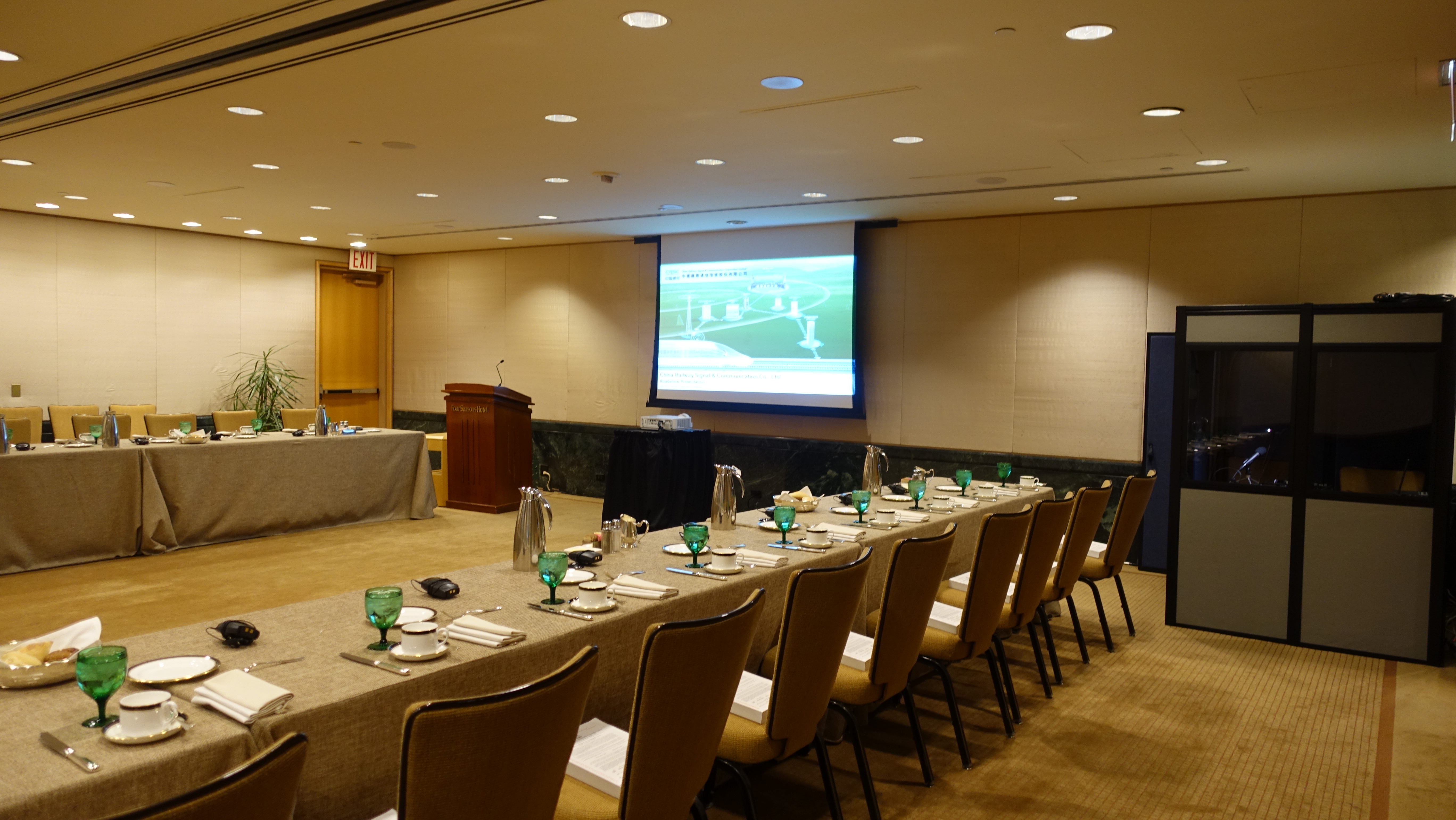>For the interpreters to hear clearly what is being said, audio of the presenter(s) is to be transmitted directly to the interpreter's station. Find out if there will be a dedicated audio feed from the AV provider so that a direct line can be run from the conference room’s PA system to the interpretation equipment. To perform their job at the best of their ability, the interpreters need to hear the speakers/presenters well at all times during the event. There are four ways to accomplish this.
1. recommended: dedicated audio feed from mixing board
the presenters or panelists are given individual microphones as part of the venue's sound reinforcement setup and the simultaneous interpretation system provider receives an audio feed from the venue's mixing board.
Best practice calls for interpreters to use headphones, a microphone and an interpreter console from where they can control the sound level during the event and make adjustments as needed. If there is sound reinforcement at the event and the interpretation equipment comes with an interpreter console (portable FM systems do not), the interpreter’s headphones should connect via the interpreter console to the sound system’s mixing board “audio out” (usually via a 3-pin male XLR floor out), which feeds the audio directly from the speakers.
the interpretation equipment provider should coordinate with the sound reinforcement provider and do a sound check prior to the start of the event.
2. alternative: headphones from mixing board
using a sound system (either the one provided by the event venue – if available – or a rental), the interpreter’s headphones are connected directly to the system’s mixing board “audio out”, which feeds the audio directly from the speakers. If the venue has an AV technician working your event, they will likely be able to do this for you. If not, you will have to set this up yourself.
(coming soon: visual of mixing board with audio out)
this is the best solution to give the interpreters quality audio when using a simultaneous interpretation system without interpreter console (like a portable FM system). You just have to make sure the interpreter’s headphones have a long enough wire to reach from the mixing board to the interpreter booth (or wherever the interpreters are going to be, if you are not using a booth). Take this into consideration while drawing your room diagram.
the downside of this approach is that, without the console, the interpreter does not have a way to control the incoming audio levels and instead relies on the technician operating the mixing board to provide an optimal sound volume. This is why it is important to test the system before the event and make sure the audio level is optimal for the interpreters.
3. workaround: ad-hoc wireless feed
if there is no sound reinforcement, you can rent an additional portable beltpack transmitter and an extra receiver. The presenter will use the transmitter on a separate channel from the one selected for the transmitter used by the interpreter. The interpreter will then tune the extra receiver to the presenter's transmitter’s channel to get a direct wireless audio feed.
for your room setup, you will have to take into account that the transmission range of a portable beltpack transmitter is approx 100 feet, so the interpreter cannot be set up farther than 100 feet from the presenter's transmitter.
in addition, since you will be working with multiple transmitters, you must make sure to leave at least two free channels between each transmitter’s frequency to avoid interference.
this solution can be acceptable for small-scale one-person presentations or if multiple presenters will await their turn to speak using the same microphone.
for scenarios with multiple presenters or panelists using table mics, in a many to many meeting, it is advisable to use discussion units or a wireless conference system that routes the microphones to a system control unit such as Bosch. To buy or rent a conference system, please visit our section AV Rental & Sales.
4. no audio feed
At times, for budgetary or technical reasons, there is no possibility to get an audio feed to the interpreter. As a last resort, you could have the interpreter simply listen naturally to the speaker - with no headphones and no audio feed.
in this scenario, the quality of the audio heard by the interpreter will be inferior as it is affected by room noise such as: audience members talking among themselves, the sound of people eating during a luncheon or dinner, waiting staff serving or clearing tables.
any extraneous noise might impair the interpreters' ability to concentrate. Some interpreters may be reluctant to accept to work without a proper audio feed. To avoid surprises, it is best to discuss the absence of an audio feed with the interpreter team or interpretation company at booking time.

IC2-2Tx.png)